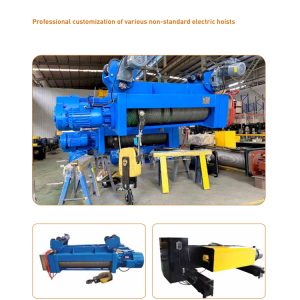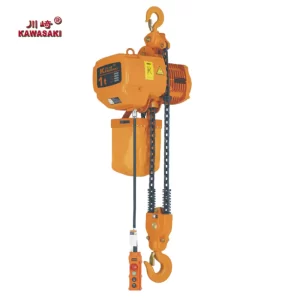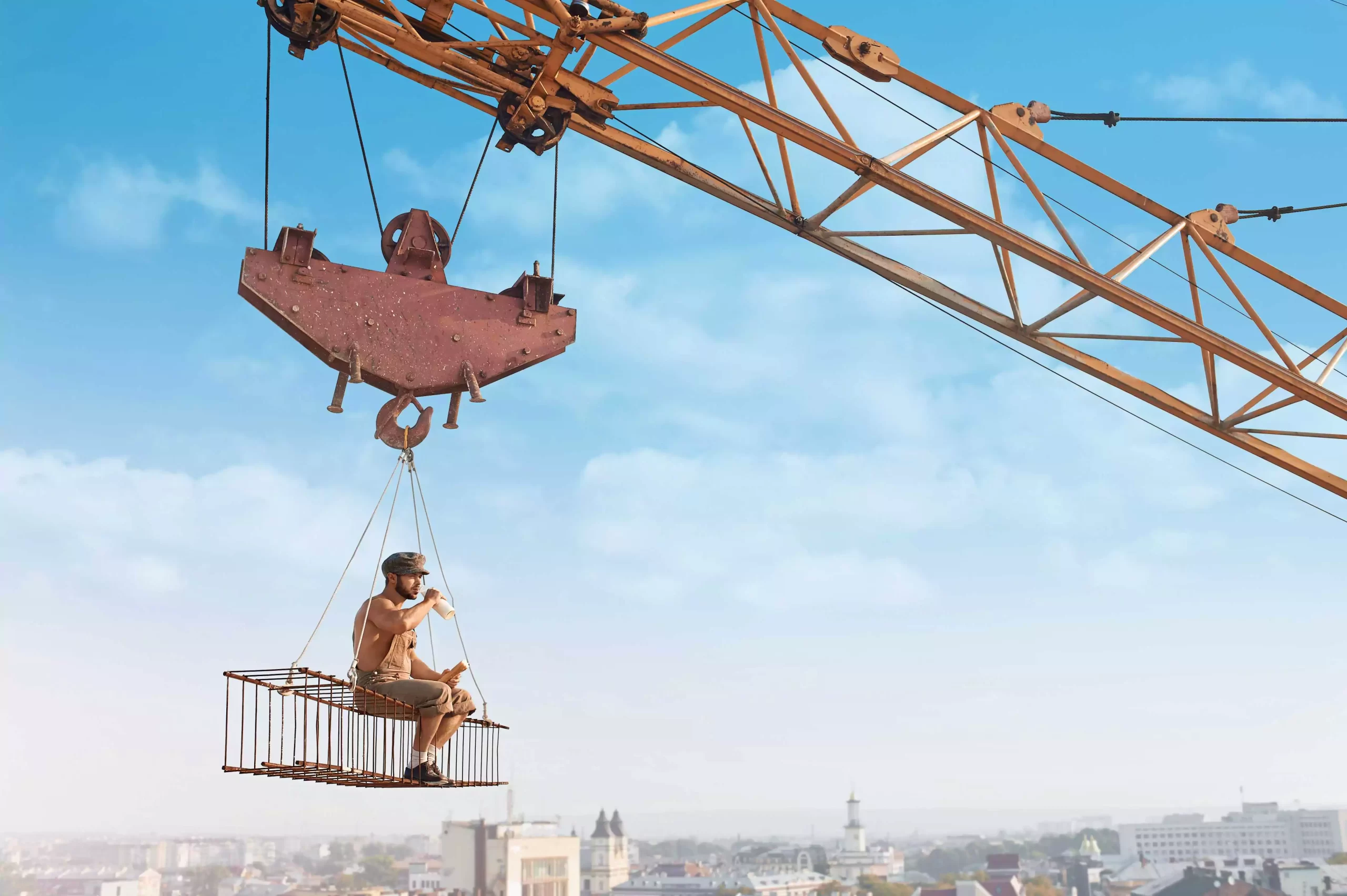Introduction
In industrial settings, the need for lifting and moving heavy objects is a common challenge. Electric hoists, including wire rope hoists and electric chain hoists, are essential tools used to lift heavy loads safely and efficiently. Both types of hoists provide unique features and are suited for different applications depending on the environment, the type of load being lifted, and the required lifting capacity. While both serve similar purposes, they differ significantly in design, functionality, and specific use cases. This article will explore the differences between wire rope electric hoists and electric chain hoists in terms of their construction, operation, advantages, disadvantages, and ideal applications.
1. Wire Rope Electric Hoist: An Overview
A wire rope electric hoist is a type of hoisting device that uses a wire rope (steel cable) to lift or lower heavy loads. The hoist is powered by an electric motor, which drives a drum or winch that winds and unwinds the wire rope, allowing the load to be raised or lowered. These hoists are typically used for lifting heavy loads in construction, manufacturing, and other industrial settings.
Key Components of Wire Rope Electric Hoist:
- Motor: Provides the power to lift the load.
- Wire Rope: A steel cable that is wound around a drum or winch to lift the load.
- Drum or Winch: A rotating component that stores the wire rope and helps lift or lower the load.
- Hook: Attached to the end of the wire rope, the hook is used to connect the hoist to the load.
- Limit Switches: Used to stop the hoist at the top and bottom limits of travel, preventing damage.
Operation of Wire Rope Electric Hoists:
- The electric motor powers the hoist, which causes the drum to rotate.
- The wire rope wraps around the drum, and as it unwinds or winds, the hook moves up or down, respectively.
- The load is lifted or lowered depending on the direction of the motor’s rotation.
- Limit switches are used to prevent the rope from over-traveling or becoming tangled.
2. Electric Chain Hoist: An Overview
An electric chain hoist is another type of hoisting device that uses a chain to lift and lower loads. Like the wire rope hoist, the electric chain hoist is powered by an electric motor. However, instead of a wire rope, it uses a durable chain that is wound around a sprocket. The chain pulls the load upward or lets it down, depending on the direction of the motor.
Key Components of Electric Chain Hoist:
- Motor: Powers the chain hoist and drives the sprocket.
- Chain: A heavy-duty metal chain used to lift the load.
- Sprocket: A toothed wheel that the chain wraps around, enabling movement.
- Hook: A hook at the end of the chain for attaching to the load.
- Limit Switches: Prevent the hoist from lifting or lowering the load beyond safe limits.
- Control Pendant: Allows the operator to control the hoist from a safe distance.
Operation of Electric Chain Hoists:
- The electric motor drives the sprocket, causing the chain to move in either direction.
- As the chain moves, the load is lifted or lowered.
- The length of the chain is adjustable, providing flexibility in lifting heights.
- Limit switches prevent the hoist from damaging itself by stopping at the top or bottom of its range.
3. Comparison of Wire Rope Hoist and Electric Chain Hoist
3.1 Lifting Capacity
One of the key differences between the two hoists is their lifting capacity. Wire rope hoists generally have a higher lifting capacity than electric chain hoists. This is due to the design of the wire rope, which is capable of withstanding greater tensile loads. For this reason, wire rope hoists are typically used in applications that require lifting heavier loads, such as construction sites, shipyards, and large manufacturing plants.
In contrast, electric chain hoists are more commonly used for lighter to medium lifting tasks. They are ideal for applications where loads do not exceed a certain weight limit. While electric chain hoists can still handle significant loads, they typically have a lower lifting capacity compared to wire rope hoists.
3.2 Lifting Speed
Electric chain hoists generally offer slower lifting speeds compared to wire rope hoists. The chain, being heavier and more rigid, tends to operate at a slower pace. This can be an advantage in applications where precise control of the lifting process is needed, such as in material handling or assembly lines.
Wire rope hoists, on the other hand, are faster due to the flexibility and lightness of the wire rope. This makes them ideal for applications that require quick lifting or lowering of loads, such as in construction, logistics, and warehouse operations.
3.3 Durability and Maintenance
When it comes to durability, wire rope hoists have a longer lifespan under the right conditions, thanks to the robust construction of the steel rope. The wire rope is highly resistant to wear and can endure longer periods of heavy-duty lifting. However, it is essential to inspect the wire rope regularly to prevent issues such as fraying or breakage.
Electric chain hoists are typically more resistant to wear in harsh environments. The chain is less prone to damage from environmental factors such as dust, moisture, and chemicals. However, the chain can stretch over time and may need to be replaced periodically. Additionally, the sprocket and other components in the chain hoist may require more frequent maintenance compared to wire rope hoists.
3.4 Compactness and Flexibility
Electric chain hoists are often more compact and easier to install than wire rope hoists. The design of the chain hoist allows it to be used in spaces where a wire rope hoist would be too bulky. For example, electric chain hoists can be easily mounted on overhead tracks, making them ideal for tight spaces such as small workshops or warehouses.
Wire rope hoists, due to their larger size and heavier components, are less compact and may require more space for installation. However, their higher lifting capacities and faster lifting speeds make them more suitable for large-scale operations.
3.5 Cost
Electric chain hoists are generally more affordable compared to wire rope hoists. This makes them an attractive option for businesses and facilities that do not require the high lifting capacities of wire rope hoists. Electric chain hoists offer a good balance of performance and cost, particularly for light- to medium-duty applications.
Wire rope hoists, being more complex and having higher lifting capacities, tend to be more expensive. The cost reflects their ability to handle heavier loads and operate at faster speeds, making them better suited for more demanding industrial tasks.
4. Advantages and Disadvantages of Each Type
4.1 Wire Rope Electric Hoists:
Advantages:
- Higher lifting capacity, making them suitable for heavy-duty applications.
- Faster lifting speeds, improving productivity.
- Long lifespan and durable in tough environments.
- Suitable for outdoor and harsh environments.
- Able to handle high tensile loads efficiently.
Disadvantages:
- Requires more maintenance, especially with wire rope inspection.
- Larger and heavier, requiring more space for installation.
- Higher initial cost compared to electric chain hoists.
4.2 Electric Chain Hoists:
Advantages:
- More compact and easier to install in confined spaces.
- Lower initial cost, making them more accessible for smaller operations.
- Resistant to environmental factors such as moisture and dust.
- Easier to maintain with fewer parts subject to wear and tear.
- Well-suited for light to medium-duty applications.
Disadvantages:
- Lower lifting capacity compared to wire rope hoists.
- Slower lifting speeds, which may impact productivity in high-volume applications.
- Can experience chain wear and stretch over time, requiring replacement.
5. Applications of Wire Rope Electric Hoists vs. Electric Chain Hoists
5.1 Applications of Wire Rope Electric Hoists:
Wire rope electric hoists are typically used in industries that require high lifting capacities and fast, reliable lifting solutions. Common applications include:
- Construction: For lifting heavy materials such as steel beams, concrete, and machinery.
- Shipbuilding: To move large components, including engines, hull sections, and equipment.
- Mining and Oil & Gas: For lifting and transporting heavy equipment and materials.
- Steel Mills: To handle heavy steel billets, coils, and other heavy products.
- Heavy Manufacturing: For assembly or installation of large machinery and industrial equipment.
5.2 Applications of Electric Chain Hoists:
Electric chain hoists are more commonly used in settings where lighter loads are handled. They are suitable for:
- Warehouses and Distribution Centers: For lifting boxes, pallets, and other medium-weight loads.
- Workshops and Small Factories: For lighter material handling tasks.
- Assembly Lines: Where precise and slower lifting is required.
- Maintenance and Repair Shops: For lifting and positioning equipment and tools.
Conclusion
In summary, both wire rope electric hoists and electric chain hoists have their strengths and weaknesses, with each being suited to specific types of work environments. Wire rope hoists excel in heavy-duty lifting, offering high lifting capacities and fast speeds. They are ideal for large-scale industrial operations where both power and speed are essential. Electric chain hoists, on the other hand, are better suited for lighter, more compact applications where cost, flexibility, and ease of installation are more critical.
Understanding the differences between these two types of hoists helps businesses make an informed decision about which equipment best suits their needs. By considering factors such as load capacity, speed, environment, and maintenance requirements, industries can optimize their material handling operations, ensuring both safety and efficiency.


